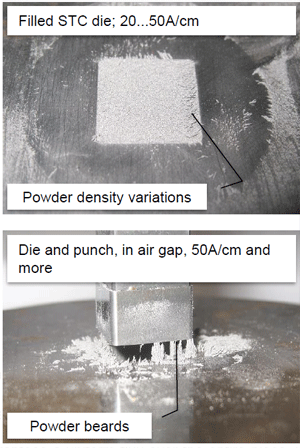The benefits of low-level demagnetization prior to the compaction of powder metallurgy parts
In this article, Maurer Magnetic AG, Switzerland, look at the problems of magnetism in the powder metallurgy compaction process, and present solutions for demagnetizing press components and powder presses.
Abstract
 Powder metallurgy parts are mainly used in mass production for the automotive industry. Short production times, precisely controlled material properties, and minimum rework of the parts make this process particularly interesting.
Powder metallurgy parts are mainly used in mass production for the automotive industry. Short production times, precisely controlled material properties, and minimum rework of the parts make this process particularly interesting.
Iimportant production cost factors are the punches and dies, which are usually made of sintered tungsten carbides and often provided with wear resistant coatings. These tools are subject to strong mechanical wear, and hence have a limited life.
Ferromagnetic sintered tungsten carbides (STC) show, in conjunction with the outstanding hardness and wear endurance, hard magnetic properties (high magnetic coercivity). After exposure to external magnetic fields, STC retain residual magnetism values of up to 100A/cm (~ 125 Gauss). As an example, for steel parts used in the automotive industry, the limit is set at 4A/cm or lower.
Continuous developments in the field of powder metallurgy allow the production of parts with increasingly narrower dimensions and weight, at an ever increasing rate of production. Complex parts with thin walls can be manufactured today by use of multi-stage press adapters and tools. The residual magnetic fields amplified in small air gaps, will thus impact progressively the compacting process of ferromagnetic powders.
Magnetic clamping and lifting systems offer great advantages in the time required for setup and handling of ferromagnetic workpieces. The usual demagnetizing functions on those systems are able to reduce previously impressed magnetization close to the initial values. However, such systems meet their performance limits when the technical requirements for low residual magnetism become lower, as in the case of the powder metallurgy.
Problems due to residual magnetism of powder presses are observed in many production facilities during degaussing services. Suitable demagnetizing and measurement instruments are often missing in the concerning companies or do not meet state of the art requirements.
The ferromagnetic powder compacting process performed with completely demagnetized tools and press structures offers the following advantages:
- Improved flow of the metal powder
- Shorter cycle times in powder compacting
- Extended lifetime of the punches and dies
- Reduced density variations of the green compact
- Less waste of powder
With modern demagnetizing machines, a safe and total degaussing of hard metal tools, adapters and press frames is achieved. In addition to this, the demagnetization of fully assembled presses with mounted adapters is possible……. Download full PDF article here
Further sections of this article include:
- Behaviour of the ferromagnetic powder on magnetic dies and punches
- Behaviour of the metal powder in perfectly demagnetized dies and punches
- Field lines in a powder compacting press with high residual magnetism
- Field lines in a demagnetized powder compacting press
- Demagnetization of press components and fully assembled powder presses
- Gain competitive advantage through your own know-how
- Modular degaussing machines for comprehensive coverage of the task
- Deployment of the demagnetizing method within the manufacturing process flow






